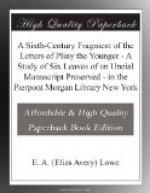7. Extreme fineness of
parchment, at least in parts of the
manuscript.
8. Perforation of parchment along furrows made by the pen.
9. Quires signed by means
of roman numerals often preceded by the
letter Q. (= Quaternio)
in the lower right corner of the last
page of each gathering.
10. Running titles, in
abbreviated form, usually in smaller
uncials than the text.
11. Colophons, in which
red and black ink alternate, usually in
large-sized uncials.
12. Use of a capital,
i.e., a larger-sized letter at the
beginning of each page or
of each column in the page, even if the
beginning falls in the middle
of a word.
13. Lack of all but the
simplest ornamentation, e.g., scroll or
ivy-leaf.
14. The restricted use
of abbreviations. Besides B. and Q. and
such suspensions as occur
in classical inscriptions only the
contracted forms of the Nomina
Sacra are found.
15. Omission of M and N allowed only at the end of a line, the omission being marked by means of a simple horizontal line (somewhat hooked at each end) placed above the line after the final vowel and not directly over it as in later uncial manuscripts.
16. Absence of nearly all punctuation.
17. The use of {Symbol: infra?} in the text where an omission has occurred, and {Symbol: supra?} after the supplied omission in the lower margin, or the same symbols reversed if the supplement is entered in the upper margin.
If we now turn to the Morgan Pliny we observe that it lacks a number of the characteristics enumerated above as belonging to the oldest type of uncial manuscripts. The parchment is not of the very thin sort. There has been no corrosion along the furrows made by the pen. The running title and colophons are in rustic capitals, not in uncials. The manner of forming such letters as {B E M R S T} differs from that employed in the oldest group.
B with the lower bow not so markedly larger than the upper.
E with the horizontal stroke placed nearer the middle.
M with the left bow tending to become a distinct curve.
R S T have gained in breadth and proportionately lost in height.
[Sidenote: Date of the Morgan manuscript]
Inasmuch as these palaeographical differences mark a tendency which reaches fuller development in later uncial manuscripts, it is clear that their presence in our manuscript is a sign of its more recent character as compared with manuscripts of the oldest type. Just as our manuscript is clearly older than the Codex Fuldensis of about the year 546, so it is clearly more recent than the Berlin Computus Paschalis of about the year 447. Its proper place is at the end of the oldest series of uncial manuscripts, which begins with the Cicero palimpsest. Its closest neighbors are, I believe, the Pliny palimpsest of St. Paul in Carinthia and the Codex Theodosianus of Turin. If we conclude by saying that the Morgan manuscript was written about the year 500 we shall probably not be far from the truth.




